

First (and only) derivational line :
( This line starts with some precursors (rhagionids and omphralids) of the empidoid wings)
As always, a "derivational line" orders venations of a series of existing [or having existed] species. It does not represent the actual phylogeny of those species, but indicates what kind of venational transformations might have taken place in the Implicate Order in the many parallel lines (morphoklines) (see below) each resulting in the venation of one of the species of the derivational line.
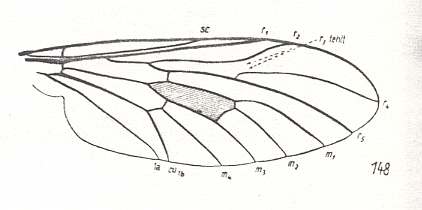 (for its position in the diagrams of morphoklines, see 1st diagram below) |
Rhagio scolopaceus, Rhagionidae. Subcosta (SC) well developed. Radial Sector (RS) 3-branched. R3 absent. Discoidal cell present. The cross-vein ta [= r-m] present in its original condition. M1, M2, M3, and M4 present. tb1 [= base of M4] present. tb2 [= m-cu] present. CuA [labelled as cu1b in the Figure] and 1A [in the Figure labelled as 1a] present, separately reaching wing-margin. |
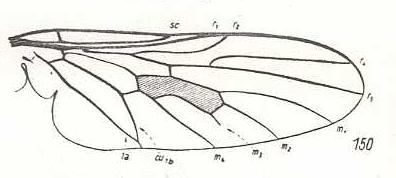 (for its position in the diagrams of morphoklines, see 1st diagram below) |
Spaniopsis clelandi, Rhagionidae. Radial Sector (RS) still 3-branched. R3 absent. M1, M2, and M4 present. M3 in the process of reduction. tb1 [= base of M4] suppressed. tb2 [= m-cu] present. CuA and 1A with a short commom stalk. |
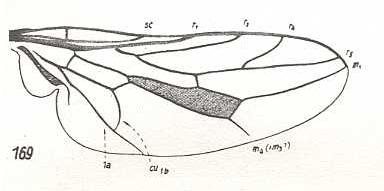 (for its position in the diagrams of morphoklines, see 1st diagram below) |
Omphrale fenestralis, Omphralidae. Radial Sector (RS) still 3-branched. R3 absent. M1 and M4 present, M2 and M3 absent. tb1 [= base of M4] suppressed. tb2 [= m-cu] present. CuA and 1A with a longer [than in Spaniopsis] commom stalk, reaching wing-margin. The wing-venation of Omphrale, although perfectly derivable from that of Spaniopsis, is a side-line, i.e. it is not a direct link between Spaniopsis and the rest of this derivational line. Its specialization consists in freeing the posterior wing-margin of veins, a process not continued in the rest of the line. |
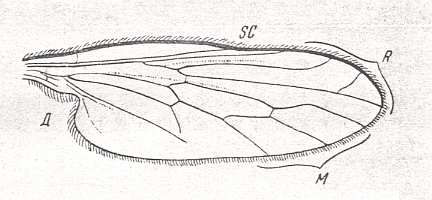 (for its position in the diagrams of morphoklines, see 1st diagram below) |
Homalocnemis nigripennis, Empididae. Length about 5 mm. Radial Sector (RS) still 3-branched, but fork of R4+5 shortened. R3 absent. M1, M2, and M4 present. M3 absent. Discoidal cell still present. tb1 [= base of M4] suppressed. tb2 [= m-cu] present. CuA and 1A converging, but not reaching hind-margin, i.e. the common stalk has disappeared. The wing-venation of this species is not derivable from that of Omphrale (because of its three M's) but reverts back to Spaniopsis. |
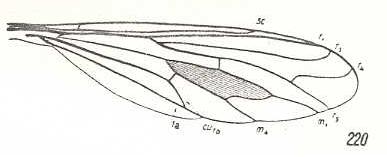 (for its position in the diagrams of morphoklines, see 1st diagram below) |
Systropus excisus, Bombyliidae. Radial Sector (RS) still 3-branched. R3 absent. M1 and M4 present, M2 and M3 absent. tb1 [= base of M4] suppressed. tb2 [= m-cu] present. CuA and 1A with a commom stalk, reaching wing-margin. |
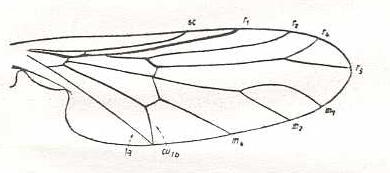 (for its position in the diagrams of morphoklines, see 1st diagram below) |
Hilarimorpha singularis, Hilarimorphidae. Radial Sector (RS) still 3-branched, fork of R4+5 short. M1, M2, and M4 present. M3 absent. The intermedial cross-vein tp vanished, therefore discoidal cell absent. CuA and 1A ending with a common point in the wing's hind-margin.
As a result of the disappearance of the discoidal cell this venation is derived (i.e. it is in a derived condition) with respect to Homalocnemis , but primitive with respect to the cubital cell (this cell is still long, and is closed only at the wing-margin). So these two venations show specialization-crossing. |
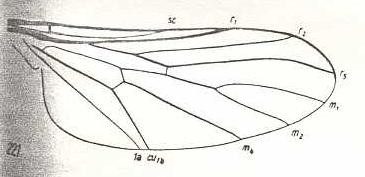 (for its position in the diagrams of morphoklines, see 1st diagram below) |
Cyrtosia meridionalis, Bombyliidae. Radial Sector (RS) has become 2-branched by loss of R4. M1, M2, and M4 present. M3 absent. The intermedial cross-vein tp vanished, therefore also in this form discoidal cell absent. CuA and 1A ending closely together in the wing's hind-margin. As a result of the disappearance of the discoidal cell also this venation is derived with respect to Homalocnemis, but primitive with respect to the cubital cell, i.e. this cell has not yet been closed. And the present venation also has a specialization-crossing with that of Systropus (number of branches of RS and M). |
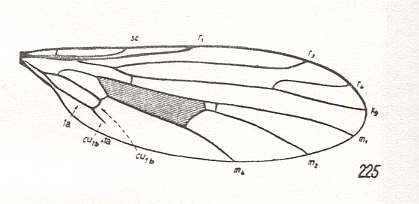 (for its position in the diagrams of morphoklines, see 2nd diagram below) |
Clinocera inermis, Empididae. Subcosta and R1 shortened. Radial Sector (RS) still 3-branched. M1, M2, and M4 present. M3 absent. Discoidal cell still present. tb1 [= base of M4] suppressed as in Homalocnemis as a result of M4 now forming the posterior margin of the discoidal cell. tb2 [= m-cu] present. CuA and 1A converging and coalescing more or less close to wing-base with a common stalk, which does, however, not reach the hind-margin of the wing. This form cannot actually be derived from Cyrtosia and neither from Hilarimorpa, because it again has a discoidal cell. It may be derived from Homalocnemis or from Systropus (but less so from the latter, because of the number of branches of M ). |
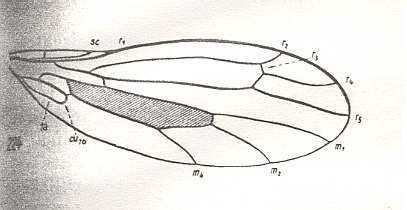 (for its position in the diagrams of morphoklines, see 2nd diagram below) |
Dolichocephala irrorata, Empididae. Subcosta and R1 markedly shortened. Radial Sector (RS) still 3-branched if not counting R3 (branching off from R2+3 and coalescing with R4). This R3 may be just an atavism, i.e. a re-activation of R3's old bed, and therefore not a primitive feature but a newly-formed [and evolutionarily merely temporary] structure. M1, M2, and M4 present. M3 absent. Discoidal cell still present. tb1 [= base of M4] suppressed. tb2 [= m-cu] present. CuA and 1A converging and coalescing already at wing-base with no common stalk. |
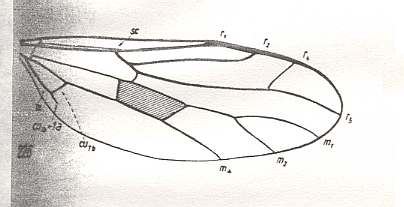 (for its position in the diagrams of morphoklines, see 2nd diagram below) |
Chelifera melanocephala, Empididae. Subcosta, and especially R1 not so much shortened as in Dolichocephala. Subcosta ending up in R1. Radial Sector (RS) 3-branched. M1, M2, and M4 present. M3 absent. M1 and M2 with a common stalk branching off from discoidal cell. tb1 [= base of M4] suppressed. tb2 [= m-cu] apparently present as a stretched-out vein, such that it is a continuation of CuA. The latter sharply bends towards 1A forming with it a triangular cubital cell. The common stalk of CuA and 1A is short and does not reach the wing-margin.
This form stands more or less on itself, but may nevertheless be placed in the present derivational line. |
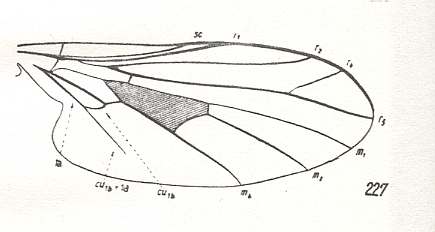 (for its position in the diagrams of morphoklines, see 2nd diagram below) |
Gloma fuscipennis, Empididae. Subcosta ending up in the Costa again and runs close to R1. Radial Sector (RS) still 3-branched. M1, M2, and M4 present. M3 absent. Discoidal cell still present. CuA strongly curving back on 1A, their common stalk not reaching wing-margin. |
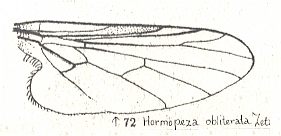 (for its position in the diagrams of morphoklines, see 2nd diagram below) |
Hormopeza obliterata, Empididae. Radial Sector (RS) still 3-branched. R2 running close to R1 M1, M2, and M4 present. M3 absent. Discoidal cell still present. CuA, as in Gloma, strongly curving back on 1A, their common stalk hardly reaching wing-margin. |
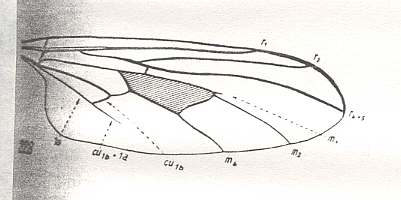 (for its position in the diagrams of morphoklines, see 2nd diagram below) |
Leptopeza flavipes, Empididae. Subcosta ending up in R1. Radial Sector (RS) becomes 2-branched, because of the disappearance of R4 (or of its coalescence with R5). M1 almost competely reduced, M2, and M4 present. Discoidal cell still present. CuA strongly curving back on 1A, their common stalk not reaching wing-margin. |
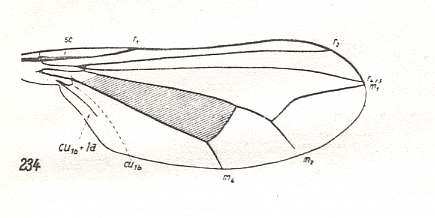 (for its position in the diagrams of morphoklines, see 3rd diagram below) |
Sciopus albifrons, Dolichopodidae. Subcosta ending up in R1. Radial Sector (RS) 2-branched. M1 and M2 having a common stalk branching off from the discoidal cell. M1 curves up towards R4+5 (or R5), as it does in many higher flies. M4 present. This is a more primitive configuration -- as to the number of Medial veins -- than it is in Leptopeza (Empididae). Discoidal cell still present. Cubital cell very small, i.e.CuA strongly curves back on 1A already at the very base of the wing. Their common stalk not reaching wing-margin.
Despite the more primitive structure of M1 and M2, the present form is clearly derived with respect to Leptopeza by the strong shift of the cubital cell toward the wing-base. |
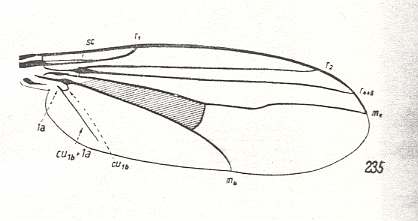 (for its position in the diagrams of morphoklines, see 3rd diagram below) |
Dolichopus picipes, Dolichopodidae. Subcosta ending up in R1. Radial Sector (RS) still 2-branched. M2 vanished. M4 still present. Common stalk of CuA and 1A longer than in Sciopus, but still not reaching wing-margin. |
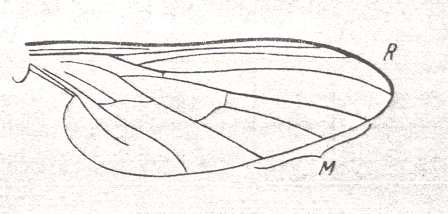 (for its position in the diagrams of morphoklines, see 3rd diagram below) |
Rhamphomyia platyptera, Empididae. Wing of male. Subcosta ending free. Radial Sector (RS) 2-branched. M1, M2 and M4 present. Discoidal cell still present. Cubital cell as in Hormopeza or Leptopeza. Common stalk of CuA and 1A reaching wing-margin. This form can best be derived from Hormopeza. |
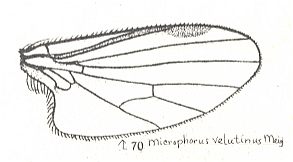 (for its position in the diagrams of morphoklines, see 3rd diagram below) |
Microphorus velutinus, Empididae. R1 very close to Subcosta. Radial Sector (RS) 2-branched. M1, M2 and M4 present. Discoidal cell still present. Cubital cell and posterior basal cell (= the cell lying directly above the cubital cell) strongly shifted to wing-base. CuA and 1A (forming the cubital cell) without common stalk. The next form (Hybos) stands more or less on its own because of the long CuA. It nevertheless has qualitative affinities with Leptopeza. |
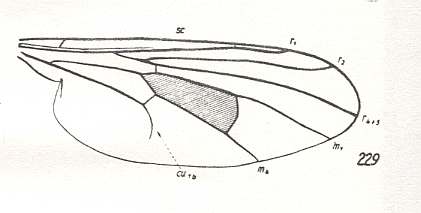 (for its position in the diagrams of morphoklines, see 3rd diagram below) |
Hybos culiciformis, Empididae. Subcosta free. Radial Sector (RS) 2-branched. M1 and M4 present. Discoidal cell still present. CuA long and curved, not reaching wing-margin. 1A absent. As has been said, this form stands more or less on its own because of the long CuA (i.e. the long cubital cell if 1A were present). It nevertheless has qualitative affinities with Leptopeza. The next form may more or less be derived from Gloma. It has lost the discoidal cell. |
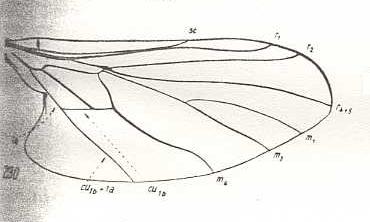 (for its position in the diagrams of morphoklines, see 3rd diagram below) |
Bicellaria nigra, Empididae. Subcosta ending up in the Costa. Radial Sector (RS) 2-branched. M1, M2 and M4 present. The intermedial cross-vein tp has vanished, therefore this form does not have a discoidal cell anymore. CuA strongly bent backwards to 1A, forming the cubital cell. Their common stalk reaching wing-margin. As has been said, this form may more or less be derived from Gloma. The next form might be derivable from Chelifera earlier in this line. |
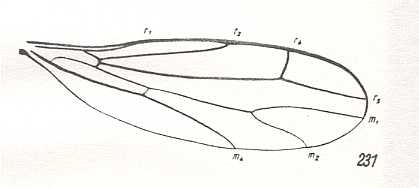 (for its position in the diagrams of morphoklines, see 4th diagram below) |
Hemerodromia raptoria, Empididae. Subcosta absent. Radius (R1) short. Radial Sector (RS) still 3-branched. M1, M2 and M4 present. The intermedial cross-vein tp has vanished, therefore this form does not have a discoidal cell anymore. The cross-vein tb1 (= base of M4) is still present, or we might interpret this feature as follows : Like in Chelifera the base of M4 is suppressed while the the base of M3+4 is still present, meaning that also in Hemerodromia the apparently preserved "base of M4" is in fact the base of M3+4. The cross-vein tb2 (= m-cu) is present, but the latter has been stretched such that it has become the continuation of the [chief part of the] vein M4 while smoothly going over into CuA, resulting in a single longitudinal vein composed of CuA, m-cu, and M4. CuA doesn't bend down (its curved end-piece is missing) and 1A has disappeared, so there is no cubital cell. Because of its 3-branched Radial Sector this form cannot be derived from the previous one (Bicellaria). So it reverts back to Chelifera above. The empidid wings that follow are similar to the present form but the Radial Sector has become 2-branched, M2 vanished, but in some species a remnant of the cubital cell is still present (while it is completely absent in Hemerodromia). |
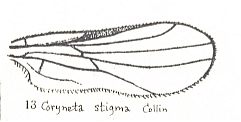 (for its position in the diagrams of morphoklines, see 4th diagram below) |
Coryneta stigma, Empididae. Radial Sector (RS) has become 2-branched. M1, and M4 present. M2 disappeared. So the Media has become 2-branched. CuA sharply bends down to 1A, forming a short cubital cell. 1A apparently not reaching wing-margin. |
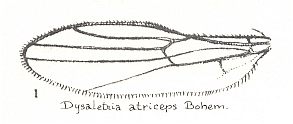 (for its position in the diagrams of morphoklines, see 4th diagram below) |
Dysaletria atriceps, Empididae. Radial Sector (RS) 2-branched. Media 2-branched. 1A apparently weakly present, and so the cubital cell. |
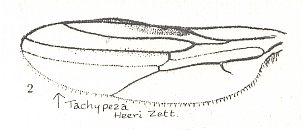 (for its position in the diagrams of morphoklines, see 4th diagram below) |
Tachypeza heeri, Empididae. Radial Sector (RS) 2-branched. Media 2-branched. 1A apparently absent, and so the cubital cell.
|
Intermezzo
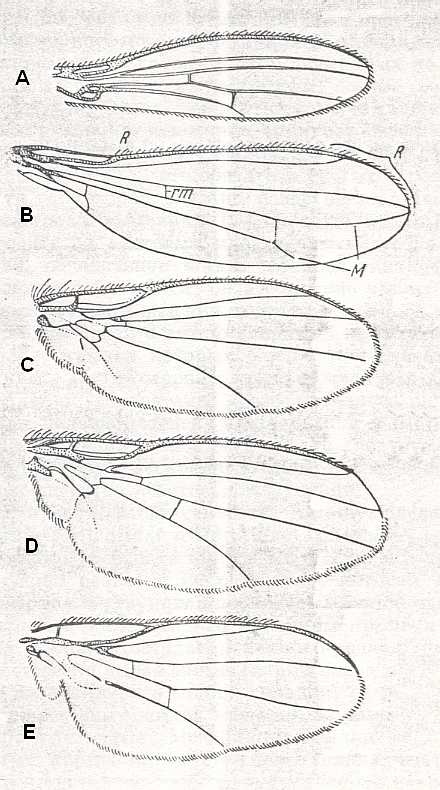
Lifting lightly-veined wings (muscoid functional type, see later documents) of representatives of the tyloid, agromyzoid, and chloropoid subtypes. From top to bottom :
Geomyza angustipennis Zett. Lauxaniidae. Length about 2 mm. (After Rübsamen, from Czerny)
Tylos corrigiolatus L. Tylidae. Length 4 mm.
Phytomyza kamtschatkensis Hend. Agromyzinae. Length about 1 mm. (After Hendel)
Agromyza frontella Rond. Agromyzinae. Length about 2 mm. (After Hendel)
Chlorops sp. Chloropidae. Length 2.5 mm.
(From ROHDENDORF, 1951)
To these we may add (also acalyptrates) :
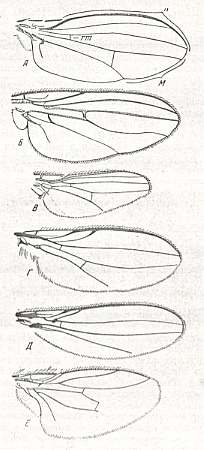
Lifting lightly-veined wings (muscoid functional type) of representatives of the drosophiloid, asteioid, and sphaeroceratoid subtypes from the family Drosophilidae. From top to bottom :
Drosophila sp. Drosophilinae. Length 4.5 mm. (range of Radial veins indicated by a brace)
Periscelis annulipes Lw. Periscelidinae. Length 3.75 mm. (After Duda)
Dinomyia ranula Lw. Canaceinae. Length about 1.75 mm. (After Becker)
Astiosoma rufifrons Duda. Asteiinae. Length 2.25 mm. (After Duda)
Asteia concinna Meig. Asteiinae. Length about 2.8 mm. (After Duda)
Limosina sp. Sphaeroceratinae. Length 3 mm.
(From ROHDENDORF, 1951)
and finally the acalyptrates :
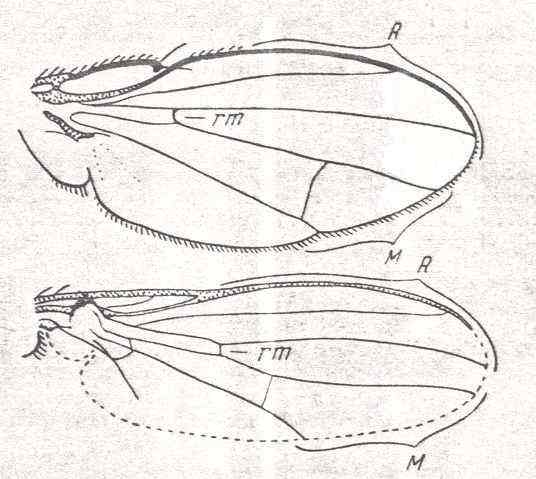
Lifting lightly-veined wings (muscoid functional type) of representatives of the anthomyioid subtype.
Top image : Dichaeta caudata Fall. Ephidridae. Length 4 mm. The Ephydridae is a highly versatile family of at least 1000 species.
Bottom image : Sepsis communis Meig. Sepsidae. Length 2.25 mm.
(After ROHDENDORF, 1951)
It is interesting to realize that the empidoid wings (in our derivational line) belong to species of the family Empididae which itself belongs in the suborder Brachycera orthorrapha, while the above examples of wings of acayptrate flies all belong to families that themselves belong in the suborder Brachycera cyclorrapha (true flies, higher flies) and functionally to the lifting lightly-veined (muscoid) wing-type. So virtually the same wing-venation is found in (otherwise) very different flies. If we think of a derivation of one from the other then it might be from acapytrate wings to corynetoid wings (the latter belonging to genera such as Tachista of the family Empididae).
The next forms of empidoid wings (continuing the above derivational line of empidoid wings) have (vitually) no trace of the cubital cell anymore. They illustrate the same venation realized in wings of various shapes (as did the examples from the acalyptrates just given).
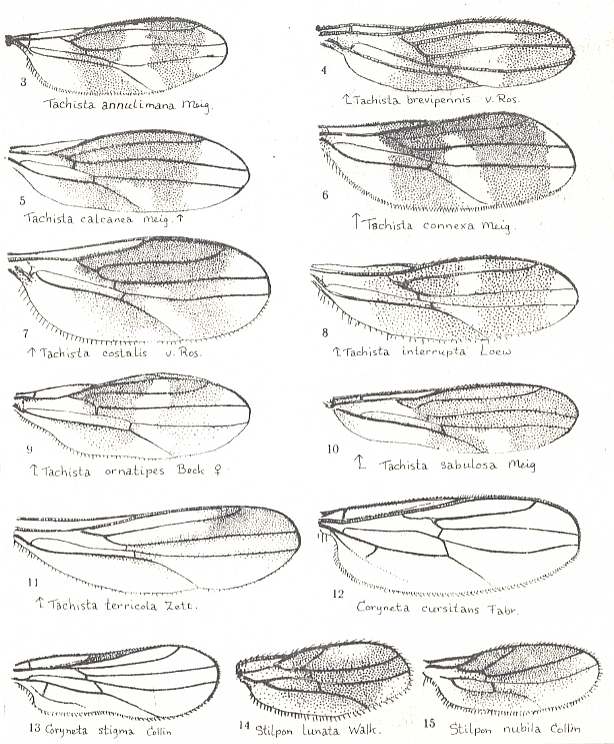 (for the position of three of them in the diagrams of morphoklines, see 4th diagram below) |
3 - Tachista annulimana, Empididae. 4 - Tachista brevipennis, Empididae. 5 - Tachista calcanea, Empididae. 6 - Tachista connexa, Empididae. 7 - Tachista costalis, Empididae. 8 - Tachista interrupta, Empididae. 9 - Tachista ornatipes, female. Empididae. 10 - Tachista sabulosa, Empididae. 11 - Tachista terricola, Empididae.
In the next two Corynetas (one of them already earlier depicted) the cubital cell is still more or less present :
14 - Stilpon lunata, Empididae. |
The last forms depicted, 3-11 (Tachista), 12-13 (Coryneta), and 14-15 (Stilpon) need not be included in our derivational line 1, because they differ little from Tachypeza, the last member of the line. In fact they are all purely parallel, i.e. repeated, developments.
The corresponding four diagrams of morphoklines are then (see the above derivational line from top to bottom) :
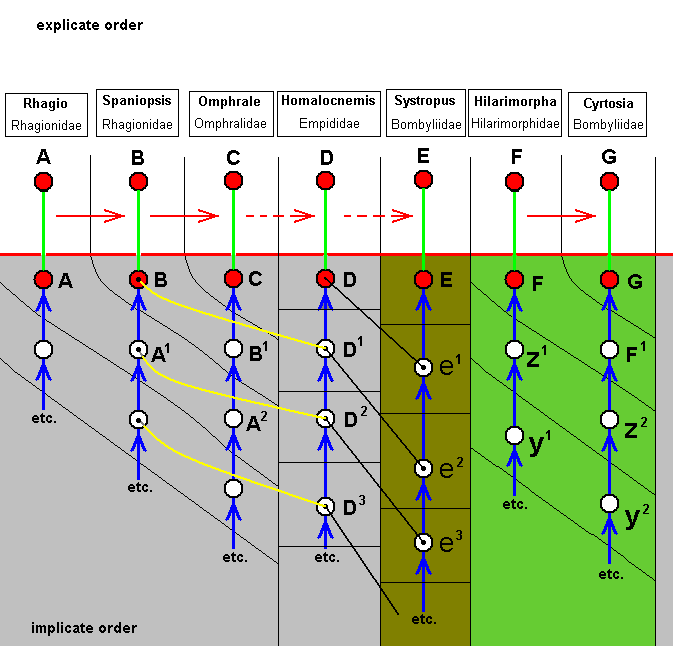
REMARK : In this last diagram we have, for instance, T, Hemerodromia, that has not noëtically originated from J, Chelifera, but from J1, which looks like J. But in the first diagram we had K, Gloma also originated from J1. So in the last diagram the naming J1 (and all items here involved) should be changed (as we had done in similar cases). But in order not to complexify matters still more we don't do it. And after all, it is certainly conceivable that from one and the same species/strategy, for instance J1, may originate more than one derived species/strategies.
It is not easy to fully express the stronger or looser derivational relationships as they were depicted in the above derivational line -- mainly consisting of empidoid venations -- in diagrams of morphoklines. The corresponding diagrams of morphoklines therefore mainly express the polyphyletic development -- in the Implicate Order -- of these species. The sequence in the derivation line of existing species and their venation is supposed to more or less reflect the courses of these (polyphyletic) noëtic transformations. What we actually "see" -- in the Explicate Order -- is not evolution, i.e. not the transformation of one form from another -- but the sequence of appearance, in the Explicate Order, of different species and types.
With all this we have concluded our exposition of empidoid wings. In the next document we will consider the large muscoid wing-type, which has its origin in certain empids.
e-mail :  ( Please write in ' Subject ' entry : ' METAPHYSICS ', in order for me to be able to distinguish your mail from spam )
( Please write in ' Subject ' entry : ' METAPHYSICS ', in order for me to be able to distinguish your mail from spam )
To continue click HERE for further study of Organic Evolution, Part LXXIV.
Back to Evolutionary Part XVII
Back to Evolutionary Part XVIII
Back to Evolutionary Part XXII
Back to Evolutionary Part XXIII
Back to Evolutionary Part XXIV
Back to Evolutionary Part XXV-A
Back to Evolutionary Part XXV-B
Back to Evolutionary Part XXV-C
Back to Evolutionary Part XXVI
Back to Evolutionary Part XXVII
Back to Evolutionary Part XXVIII
Back to Evolutionary Part XXVIII-A
Back to Evolutionary Part XXIX
Back to Evolutionary Part XXXI
Back to Evolutionary Part XXXII
Back to Evolutionary Part XXXIII
Back to Evolutionary Part XXXIV
Back to Evolutionary Part XXXV
Back to Evolutionary Part XXXVI
Back to Evolutionary Part XXXVII
Back to Evolutionary Part XXXVIII
Back to Evolutionary Part XXXIX
Back to Evolutionary Part XLII
Back to Evolutionary Part XLIII
Back to Evolutionary Part XLIV
Back to Evolutionary Part XLVI
Back to Evolutionary Part XLVII
Back to Evolutionary Part XLVIII
Back to Evolutionary Part XLIX
Back to Evolutionary Part LIII
Back to Evolutionary Part LVII
Back to Evolutionary Part LVIII
Back to Evolutionary Part LXII
Back to Evolutionary Part LXIII
Back to Evolutionary Part LXIV
Back to Evolutionary Part LXVI
Back to Evolutionary Part LXVII
Back to Evolutionary Part LXVIII
Back to Evolutionary Part LXIX
Back to Evolutionary Part LXXa
Back to Evolutionary Part LXXb
Back to Evolutionary Part LXXI
Back to Evolutionary Part LXXI
Back to Evolutionary Part LXXII
Back to Evolutionary Part LXXIIa
Back to Evolutionary Part LXXIII